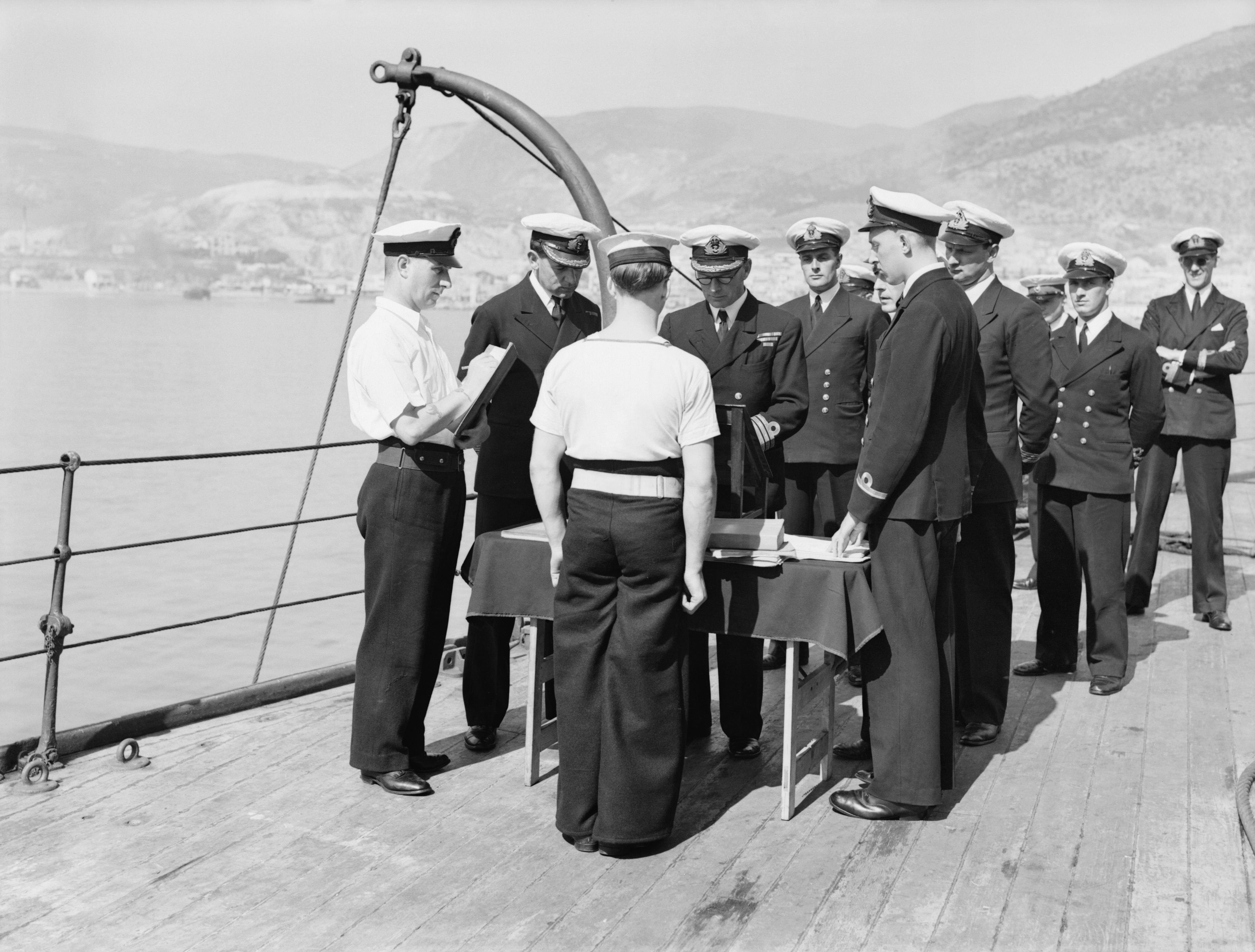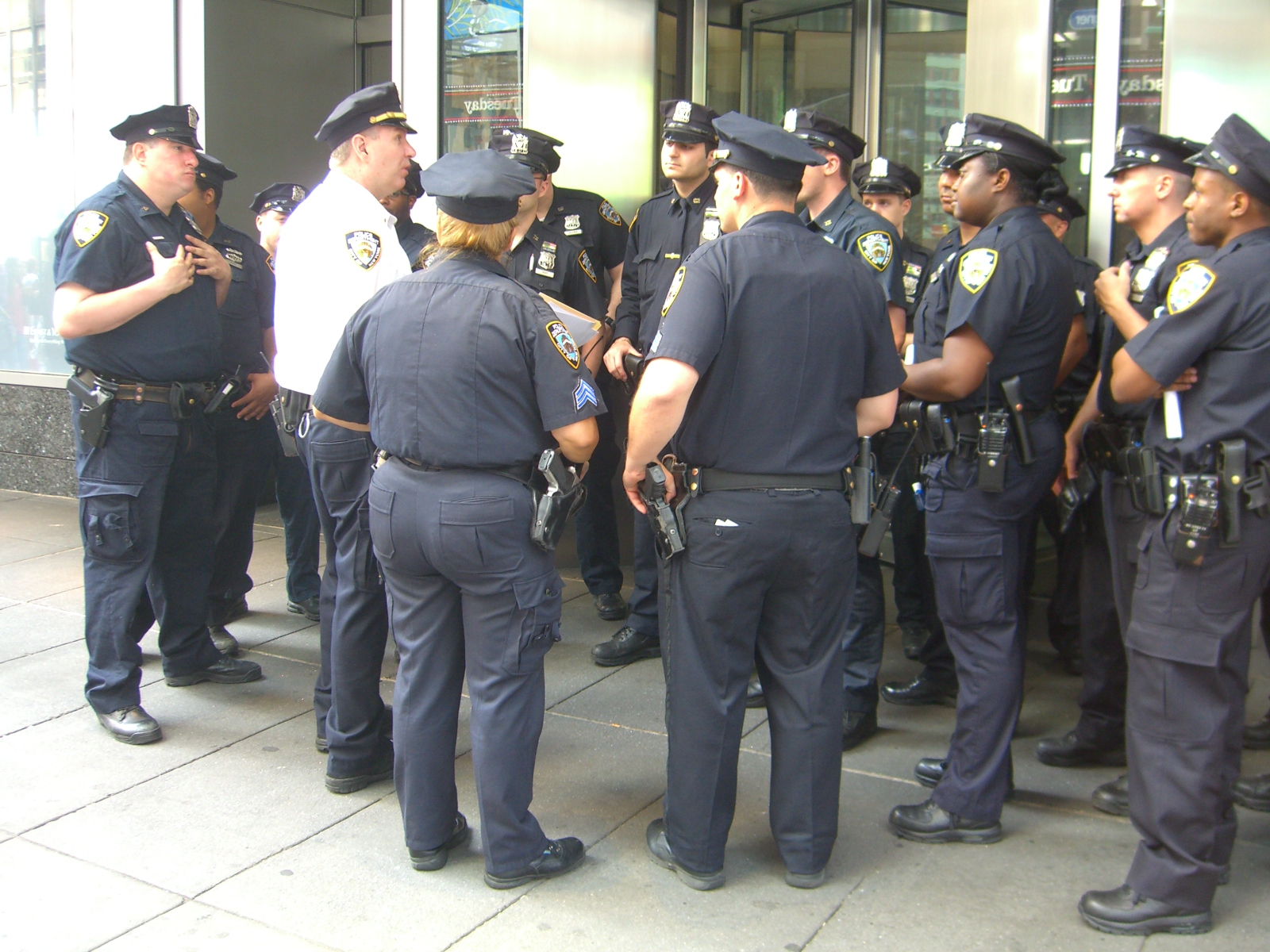|
Master-at-arms
A Master-at-Arms (US: MA; UK & some Commonwealth: MAA) may be a naval rating, responsible for law enforcement, regulating duties, security, anti-terrorism/force protection (AT/FP) for/of a country's navy; an army officer responsible for physical training; or a member of the crew of a merchant ship (usually a passenger vessel) responsible for security and law enforcement. In some navies, a ship's corporal is a position—not the rank—of a petty officer who assists the master-at-arms in his various duties. Historically, a master-at-arms was responsible for the training of soldiers during peace time, or actively involved in leading the defense of a fortification during war time. In some countries, the term "Navy Police" is used for an institution part of a navy responsible for law enforcement, such as the Royal Navy Police, known as the Royal Navy Regulating Branch until 2007. South Africa United Kingdom Royal Navy The master-at-arms (MAA) is a ship's senior rating, normal ... [...More Info...] [...Related Items...] OR: [Wikipedia] [Google] [Baidu] |
Royal Navy Police
The Royal Navy Police (RNP) is the service police branch of the Royal Navy and Royal Marines. Members of the RNP enforce service law and discipline. The Royal Navy Police was known as the Royal Navy Regulating Branch until 2007, when the service was renamed the Royal Navy Police in a change brought about by the Armed Forces Act 2006. Members were known as "Regulators" until 2009, since then they have been known as Royal Navy Police. The RNP subsumed the Royal Marines Police in 2009, although for operational purposes the majority of the two cadres of personnel are employed within their respective areas of the service. The RNP provides a Troop strength unit of Royal Marines to 3 Commando Brigade to provide policing services as part of the UK Landing force. The motto of the RNP is ''Ne Cede Malis'' which translates from Latin into English as 'Do not yield to adversity' or 'Do not give in to evil'. The RNP is the smallest of all police branches in the three services, with its prov ... [...More Info...] [...Related Items...] OR: [Wikipedia] [Google] [Baidu] |
Officer (armed Forces)
An officer is a person who holds a position of authority as a member of an armed force or uniformed service. Broadly speaking, "officer" means a commissioned officer, a non-commissioned officer, or a warrant officer. However, absent contextual qualification, the term typically refers only to a force's ''commissioned officers'', the more senior members who derive their authority from a commission from the head of state. Numbers The proportion of officers varies greatly. Commissioned officers typically make up between an eighth and a fifth of modern armed forces personnel. In 2013, officers were the senior 17% of the British armed forces, and the senior 13.7% of the French armed forces. In 2012, officers made up about 18% of the German armed forces, and about 17.2% of the United States armed forces. Historically, however, armed forces have generally had much lower proportions of officers. During the First World War, fewer than 5% of British soldiers were officers (partly ... [...More Info...] [...Related Items...] OR: [Wikipedia] [Google] [Baidu] |
United States Navy
The United States Navy (USN) is the maritime service branch of the United States Armed Forces and one of the eight uniformed services of the United States. It is the largest and most powerful navy in the world, with the estimated tonnage of its active battle fleet alone exceeding the next 13 navies combined, including 11 allies or partner nations of the United States as of 2015. It has the highest combined battle fleet tonnage (4,635,628 tonnes as of 2019) and the world's largest aircraft carrier fleet, with eleven in service, two new carriers under construction, and five other carriers planned. With 336,978 personnel on active duty and 101,583 in the Ready Reserve, the United States Navy is the third largest of the United States military service branches in terms of personnel. It has 290 deployable combat vessels and more than 2,623 operational aircraft . The United States Navy traces its origins to the Continental Navy, which was established during the American Revo ... [...More Info...] [...Related Items...] OR: [Wikipedia] [Google] [Baidu] |
Physical Training Instructor
Physical training instructor (PTI) is a term used primarily in the British Armed Forces and British police, as well as some other Commonwealth countries, for an instructor in physical fitness. United Kingdom In the British Army, specialist Physical Training Instructors (PTIs) of the Royal Army Physical Training Corps are attached to individual units to oversee physical training and manage military gymnasiums. They are assisted by All Arm Physical Training Instructors (AAPTIs), previously known as Assistant Physical Training Instructors (APTIs), who have other jobs within their unit as well as being qualified, but not specialist, physical training instructors. The PTI badge consists of crossed swords. Physical training instructors in the Royal Navy are officially titled Physical Trainers and are known as "club swingers" or "clubs" from the crossed clubs they wear as a rate badge. In the Royal Air Force, the PTI badge consists of crossed swords with an eagle in the centre. New Z ... [...More Info...] [...Related Items...] OR: [Wikipedia] [Google] [Baidu] |
Staff Sergeant
Staff sergeant is a rank of non-commissioned officer used in the armed forces of many countries. It is also a police rank in some police services. History of title In origin, certain senior sergeants were assigned to administrative, supervisory, or other specialist duties as part of the staff of a British Army regiment. As such they held seniority over sergeants who were members of a battalion or company, and were paid correspondingly increased wages. Their seniority was indicated by a crown worn above the three sergeant's stripes on their uniform rank markings. National variations Australia In the Australian Army and Cadets, the rank of staff sergeant is being phased out. It was usually held by the company quartermaster sergeant or the holders of other administrative roles. Staff sergeants are always addressed as "Staff Sergeant" or "Staff", never as "Sergeant" as it degrades their rank. "Chief" is another nickname though this is only used for the company chief clerk (in s ... [...More Info...] [...Related Items...] OR: [Wikipedia] [Google] [Baidu] |
Warrant Officer Class III
A warrant officer (WO) in the British Armed Forces is a member of the highest group of non-commissioned ranks, holding the King's (or Queen's) warrant, which is signed by the Secretary of State for Defence. Warrant officers are not saluted, because they do not hold the King's Commission, but they are addressed as "Sir" or "Ma'am" by subordinates. Commissioned officers may address warrant officers either by their appointment (e.g. QMSI, RSM or sergeant major) or as "Mister", "Mrs" or "Ms", and then their last name, e.g. "Mr Smith". Although often referred to along with non-commissioned officers (NCOs), they are not NCOs, but members of a separate group (traditional official terminology for the personnel of a unit is "the officers, warrant officers, non-commissioned officers and men"), although all have been promoted from NCO rank. In November 2018, the most senior warrant officer and most senior other ranks position was created, titled Senior Enlisted Advisor to the Chiefs of Staf ... [...More Info...] [...Related Items...] OR: [Wikipedia] [Google] [Baidu] |
Royal Army Physical Training Corps
The Royal Army Physical Training Corps (RAPTC) is the British Army corps responsible for physical fitness and physical education and has been headquartered in Aldershot since its foundation in 1860. Its members are all Royal Army Physical Training Corps Instructors (RAPTCIs). History During the Crimean War about 27,000 British troops died - the majority not as a result of wounds in battle but of disease. Investigations after the War concluded that so many had died because of their poor physical condition, resulting in their inability to fight off the effects of the diseases. In 1860 a number of military reforms began, including an investigation of methods of improving the physical fitness of soldiers in the Army. In 1859 the War Office sent Colonel Frederick William Hamilton and Dr. Thomas Galbraith Logan, the Inspector General of Hospitals, to France and Prussia to report on the physical training systems in the armies in those countries. Their report stated that the French army h ... [...More Info...] [...Related Items...] OR: [Wikipedia] [Google] [Baidu] |
First Sea Lord
The First Sea Lord and Chief of the Naval Staff (1SL/CNS) is the military head of the Royal Navy and Naval Service of the United Kingdom. The First Sea Lord is usually the highest ranking and most senior admiral to serve in the British Armed Forces unless either the Chief or Vice-Chief of the Defence Staff are naval officers. Admiral Ben Key was appointed First Sea Lord in November 2021. Originally titled the "Senior Naval Lord to the Board of Admiralty" when the post was created in 1689, the office was re-styled "First Naval Lord" in 1771. The concept of a professional "First Naval Lord" was introduced in 1805, and the title of the office was changed to "First Sea Lord" on the appointment of Sir John Fisher in 1904. Since 1923, the First Sea Lord has been a member of the Chiefs of Staff Committee; he now sits on the Defence Council and the Admiralty Board. [...More Info...] [...Related Items...] OR: [Wikipedia] [Google] [Baidu] |
British Army
The British Army is the principal land warfare force of the United Kingdom, a part of the British Armed Forces along with the Royal Navy and the Royal Air Force. , the British Army comprises 79,380 regular full-time personnel, 4,090 Gurkhas, and 28,330 volunteer reserve personnel. The modern British Army traces back to 1707, with antecedents in the English Army and Scots Army that were created during the Restoration in 1660. The term ''British Army'' was adopted in 1707 after the Acts of Union between England and Scotland. Members of the British Army swear allegiance to the monarch as their commander-in-chief, but the Bill of Rights of 1689 and Claim of Right Act 1689 require parliamentary consent for the Crown to maintain a peacetime standing army. Therefore, Parliament approves the army by passing an Armed Forces Act at least once every five years. The army is administered by the Ministry of Defence and commanded by the Chief of the General Staff. The Brit ... [...More Info...] [...Related Items...] OR: [Wikipedia] [Google] [Baidu] |
Law Enforcement
Law enforcement is the activity of some members of government who act in an organized manner to enforce the law by discovering, deterring, rehabilitating, or punishing people who violate the rules and norms governing that society. The term encompasses police, courts, and corrections. These three components may operate independently of each other or collectively, through the use of record sharing and mutual cooperation. The concept of law enforcement dates back to ancient times, and forms of law enforcement and police have existed in various forms across many human societies. Modern state legal codes use the term peace officer, or law enforcement officer, to include every person vested by the legislating state with police power or authority; traditionally, anyone sworn or badged, who can arrest any person for a violation of criminal law, is included under the umbrella term of law enforcement. Although law enforcement may be most concerned with the prevention and punishment o ... [...More Info...] [...Related Items...] OR: [Wikipedia] [Google] [Baidu] |




